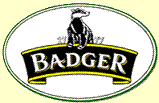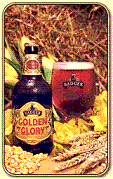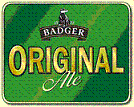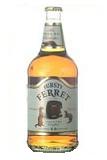Badger Brewery and its Tanglefoot and Blandford Fly

The most recognisable of beers from the present-day Badger Brewery is Badger Tanglefoot. Tanglefoot is a traditional premium ale. Full-bodied and light-golen in colour, this fantastic Badger beer has its origins many years ago, when the Head Brewer invited his staff in for a tasting of his new beer. He hoped that someone would help him coin a name for it. It was such a tasty beer that, to his surprise, several tankards of it were consumed. It was also a deceptively powerful beer, and when he stood up, he lost his footing. From this amusing incident, the name of the beer was chosen - Tanglefoot.
With a full-bodied texture, it has fruit and biscuit notes in its flavour, medium bitterness and hints of pear and melon. It is along with a smooth, hoppy flavour - a hops that lingers into the aftertaste. It is a clean finish. There are flowers and hops in the aroma, and at a premium 5% proof, it's a great traditional beer. That is, if you buy it as a bottled beer. In draught form, it is a marginally less powerful 4.9% ABV.

Due to its origins, Badger Tanglefoot has acquired the slogan "Deceptively Drinkable". Some regard it as one of the best beers in the world. It has won several prestigious awards over the years. In 1987, Tanglefoot was the overall winner in the 45-50OG class of the Brewing Industry International Awards. It also later won Bronze in the Premium Ale category of OLN's Internation Beer and Cider Competition - from 230 beers and ciders judged by 40 experts. Badger Tanglefoot has had a fantastic run, and is available nationally in a growing number of outlets
Badger is an independent brewery which has gained a great amount of respect throughout its long history. It is now being run by the 5th generation of the Woodhouse Family. The story of the Badger Brewery began in the town of Blandford St Mary, in the village of Ansty, located in a rolling countryside setting in Dorset.
Charles Hall was born in 1751. He was a farmer's son and, according to long-held tradition, was taught both farming and brewing. Farm workers were provided ale by the farmer in order to provide them with wholesome refreshment. It was in 1777 that charles started the Ansty Brewery
The Napoleonic wars helped the brewery to expand, when it capitolised on supplying beer to the army on the coast near Weymouth. Longer term business was gained by supplying beer to local taverns - in the villages around the brewery.
By 1847, Charles' son Robert had taken charge of the brewery. It was in that year that he took on George Woodhouse as a partner. George married a granddaughter of Charles Hall. The Hall & Woodhouse legacy had begun in earnest. However, it was in 1875 when the "Badger" made its first appearance, when the image of this animal was taken as the logo for Hall & Woodhouse. It is now the oldest registered trade mark in the country.
Over the course of the 1900's, Hall & Woodhouse gradually bought small inns and microbreweries, expanding their influence. In 1899, the newly-named Badger Brewery built a new brewery on the bank of the River Stout, still in Blandford St Mary, for a whopping £28,000. The original Ansty Brewery suddenly and unexpectedly burnt down, meaning that the new Badger Brewery came into use sooner than thought. It opened officially on 16th October 1900. The new century was the beginning of a whole new exciting era for Badger beers - an era in which it would become a major player in the British beer scene.
In spite of major set-backs, such as the Depression, the Badger Brewery expanded its range of range and began shipping wine and supplying off-licences. 1930 saw the first Best Bitter in the country put into a can. That when Badger first took its stake in the innovative beer take-home market.
Major expansion took place in 1963, when the brewery acquired the local brewery, Matthews & Co, along with its 61 pubs. This was just the latest in a long series of astute decisions by the brewery that smoothed its path to fame. The history of Badger is replete with decision focussed on taking advantage of new developments and changing trends, that would make the brewery more money.
Major brewing awards began to stream into the Badger Brewery's hands in the 1970's and 80's, gaining it yet further esteem. In 1987, Tanglefoot established itself by winning Double Gold Metal at the Brewing Industry International Awards - the News of the World newspaper even declared it the "best beer in Britain"! To this day, Badger's beer manufacture has stuck to its high standards, continuing to use pure brewing water from its own well.
Badger Blandford Fly is another fantastic beer they brew all year round. It is light in colour with medium body and low bitterness. It has a sublte ginger spice character, and is warming on the soul, even when served extra chilled. It's named after the Blandford Fly, which is a resident insect of the River Stout, on the banks of which the Badger Brewery is located.
Legend has it that zinzibain, one of the constituents of ginger, helps reduce swelling and fever from a bite by the dreaded Blandford Fly. It is for this reason that Badger Blandford Fly is brewed with a touch of ginger. "Beware of the Blandford Fly" is allegedly often heard being shouted by local residents. At 5.2% ABV, this is a tasty premium-strength beer.
The water that comes from the brewery's well comes filtered through Dorset's chalk downlands - an area that also gives birth to the barley that is used in the malt for Badger beers, sourced, it claims, from the finest maltsters in the area. The hops used in Badger's beers are Northdown and Challenger - English bitter and aromatic hops. They are both rich in hop oils, giving rise to the sweetness and bitterness that form part of the unique identity of Badger ales. The yeast used in brewing has the most interesting history. The same strain of yeast has been used since 1934, when it was last changed. It has been pitched from brew to brew ever since.
Fursty Ferret, a rising star in Badger, was originally brewed by the Gribble Inn microbrewery, but the recipe was taken over by Badger. It was however changed slightly to meet the needs of modern consumers. It's name derives from the legend that ferrets used to make way into the Gribble Inn at night and drink what they could of the beer.
Badger Fursty Ferret is a well balanced, crisp premium ale. It possesses a malty palate and hoppy aroma. It comes in at a respectable 4.4% ABV.

Another award-winner is Badger Golden Glory, a 4.5% proof beer characterised by its peach blossom flavour - an adjunct based on the legend that peach blossom brings good fortune to the recipient. Golden Glory is a very refreshing and floral beer, well balanced by its bitterness. Its unique, amazing flavour and aroma of peaches and melons helped it to win both the Beers and Ciders category of the high-profile Food and Drinks Awards and the Tesco Beer Challenge (beating 84 other ales) - both in the same year, 2001.

Badger First Gold is another of the more recent additions to the menagerie of Badger beers. A golden brown country ale, it took a whole two years to develop. It's fresh and clean, perfect with traditional English pies. At 4% ABV, it's a great session ale, and with its hints of spices and oranges, it's a real treat. This comes with a well-balanced bitterness from a single English hop variety, achieving great English flavour and character. As with most up-and-coming Badger ales, First Gold is increasingly available up and down the country.

A second Badger beer to win the Beers and Ciders category of the Quality Food and Drink Awards (this time in 2002), was Golden Champion Ale. A beer of elderflower aroma and light refreshing character, it was also the outright winner of the 1998 Tesco Spring and Summer Challenge, beating 100 quality beers.
Despite the addition of honey, it has a delicate, clean, crisp depth of flavour, appealing to both ale and lager drinkers. It is 5% ABV. A fantastic summer beer, it was chosen by the BBC Food and Drink Show as the best choice for summer drinking. They described it as "divine".

Finally, who can forget Badger Original. At 3.8% ABV, it is a beer inspired by old recipes for ales given to farm workers in the 1700's and also to those soldiers during the Napoleonic War. It's a premium adaptation of the draught Badger Best Bitter. It is a well-hopped country ale with a malty flavour, subtle fruity notes and a smooth finish. It is pleasantly bitter.
Badger, Fursty Ferret, 4.4% ABV
 Both a lot and little can be said about Fursty Ferret all at the same time. I first tried this in Wetherspoons on draught, and thought it was malty and yeasty, with a lot of sharpness in the aftertaste. Admittedly, it’s far better in bottle. It is a dry to medium-dry beer, with yeast scents, also fresh fruits, but dominated by malt. The taste of the bottled beer is also dominated by malt, accompanied by bitterness and a citrus feel.
Both a lot and little can be said about Fursty Ferret all at the same time. I first tried this in Wetherspoons on draught, and thought it was malty and yeasty, with a lot of sharpness in the aftertaste. Admittedly, it’s far better in bottle. It is a dry to medium-dry beer, with yeast scents, also fresh fruits, but dominated by malt. The taste of the bottled beer is also dominated by malt, accompanied by bitterness and a citrus feel.
It also finishes yeasty, with a tingliness felt at the back of the throat. Hints of blackberries are also lurking somewhere in there. A medium to highly carbonated beer, it has a slightly sharp and bitter texture, also with pleasant hints of dry hops and chocolate. The head of froth is not an awful lot to talk about – rather bubbly and thin, though forming some lacing around the sides of the glass. Despite being a full- to medium-bodied beer, it somehow lacks character, its bitterness and fizz doing it no favours. Definitely try it, though.
As well as England's Badger Fursty Ferret beer, check out the other English beers, or browse the world beers section.
 Both a lot and little can be said about Fursty Ferret all at the same time. I first tried this in Wetherspoons on draught, and thought it was malty and yeasty, with a lot of sharpness in the aftertaste. Admittedly, it’s far better in bottle. It is a dry to medium-dry beer, with yeast scents, also fresh fruits, but dominated by malt. The taste of the bottled beer is also dominated by malt, accompanied by bitterness and a citrus feel.
Both a lot and little can be said about Fursty Ferret all at the same time. I first tried this in Wetherspoons on draught, and thought it was malty and yeasty, with a lot of sharpness in the aftertaste. Admittedly, it’s far better in bottle. It is a dry to medium-dry beer, with yeast scents, also fresh fruits, but dominated by malt. The taste of the bottled beer is also dominated by malt, accompanied by bitterness and a citrus feel.




